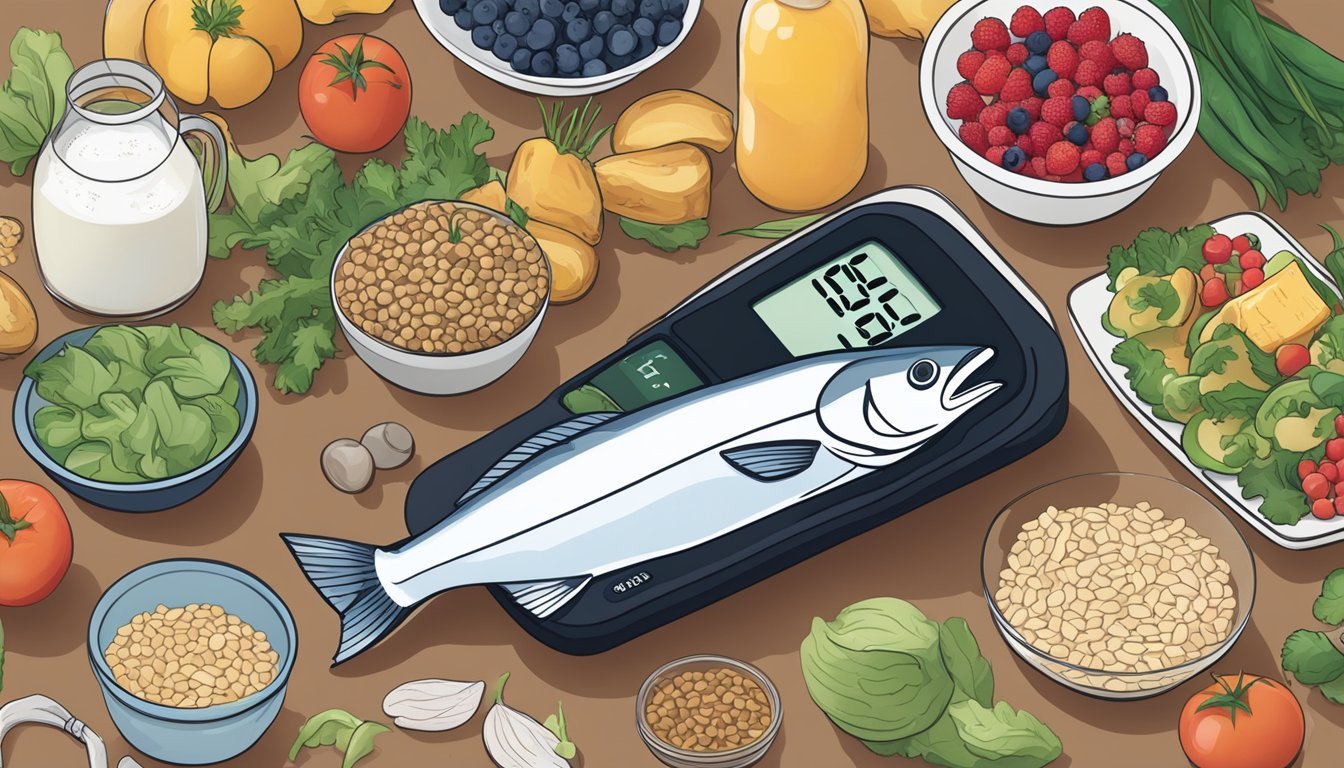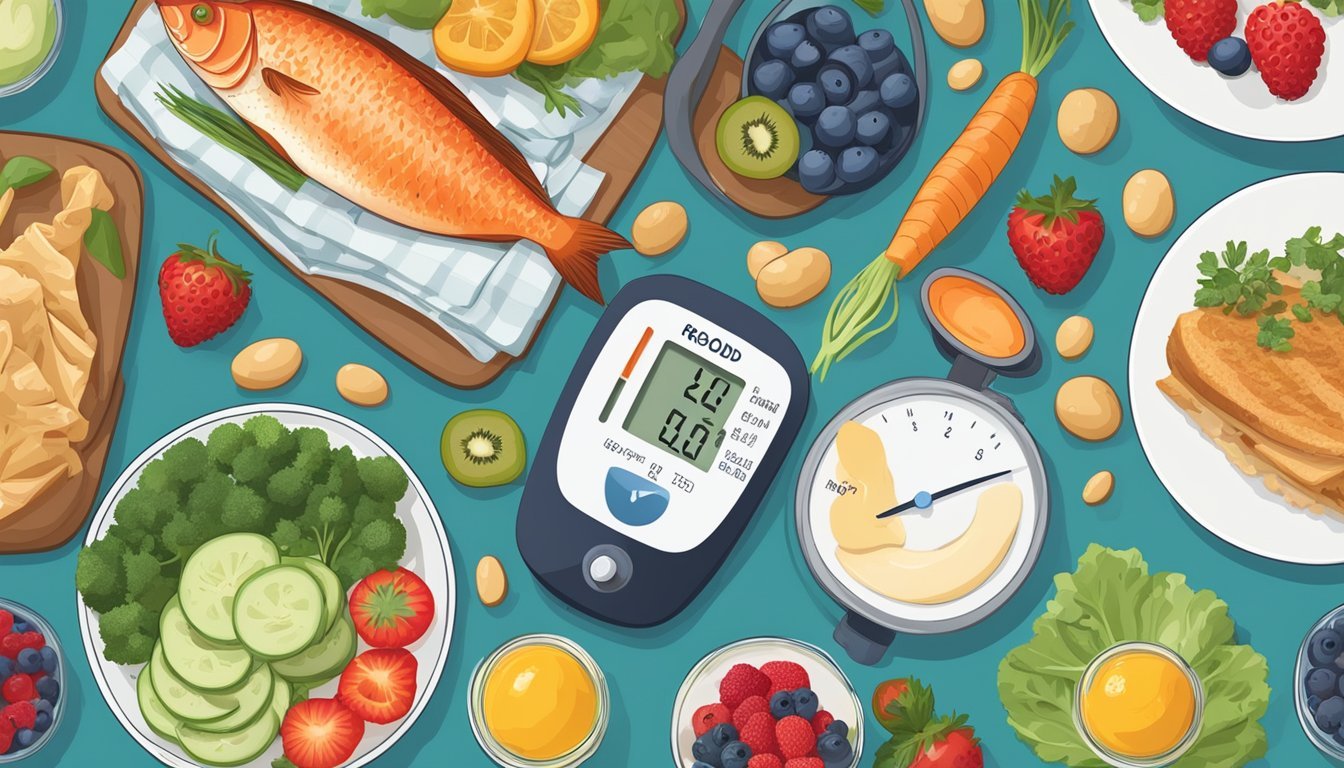How Does the Nordic Diet Affect Blood Pressure?
Uncovering the Health Impact
The Nordic diet, a nutritional approach originating from Scandinavian countries, emphasizes the consumption of whole foods such as whole grains, fruits, seafood, legumes, and canola oil. Rye, barley, and oats are prominent grains in this diet, often sourced locally and in season. This dietary pattern gives significant importance to fruits and vegetables, with a specific focus on berries, and incorporates fish and lean meats, with less emphasis on red or processed meats.
Studies have indicated that adhering to the Nordic diet can have beneficial effects on blood pressure—a crucial marker for cardiovascular health. Research published in peer-reviewed journals suggests that individuals following this dietary pattern may experience a reduction in diastolic blood pressure, which is the lower number in a blood pressure reading and represents the pressure in the arteries when the heart rests between beats. Furthermore, the mean arterial pressure, which is the average pressure in an individual's arteries during one cardiac cycle, also appears to be positively influenced by the Nordic diet.
Given the potential health benefits, the Nordic diet has garnered attention not only for its impact on blood pressure but also for its emphasis on sustainability and eco-friendliness. This diet encourages the consumption of locally sourced foods, aligning with a broader global movement towards sustainable eating practices. Consequently, the Nordic diet aligns with a healthy eating pattern that supports both personal health and environmental stewardship.
Nordic Diet Overview
This section provides a focused look at the Nordic diet, its components relevant to blood pressure management, and its distinction from the popular Mediterranean diet.
Defining the Nordic Diet
The Nordic diet is a nutritional concept modeled after the traditional eating patterns of countries like Denmark, Norway, Sweden, Finland, and Iceland. It emphasizes the intake of whole foods that are typically locally sourced and sustainable.
Constituents of the Nordic Diet
Key components include:
Whole Grains: Predominantly rye, barley, and oats.
Protein Sources: A focus on fish as a staple, along with moderate amounts of other proteins.
Fruits and Berries: A high consumption of berries and other fruits, favoring those that are in season.
Vegetables: Ample portions of vegetables, aligning with a plant-based approach.
Fats: Incorporation of fats primarily from canola oil, known for its unsaturated fat content.
Sugar: Minimal use of refined sugar, prioritizing natural sweetness from fruits.
Comparison with Mediterranean Diet
Both the Nordic and Mediterranean diets prioritize plant-based foods and fish over red meat, however, the types of fats in focus differ. The Mediterranean diet is renowned for its use of olive oil, while the Nordic diet incorporates canola oil. Both diets are acknowledged for their health benefits, including potential impacts on blood pressure.
Health Benefits of the Nordic Diet
The Nordic Diet, rich in whole foods, has shown to contribute positively to cardiovascular health, weight management, and metabolic control. It is characterized by high consumption of fruits, vegetables, and seafood, providing a good balance of healthy fats, particularly omega-3 fatty acids.
Impact on Heart Disease
The Nordic Diet, with its emphasis on omega-3 fatty acids from fish and healthy fats from nuts and seeds, can support heart health by improving cholesterol levels. Research suggests it boosts the high-density lipoprotein (HDL), known as "good" cholesterol, and helps in lowering low-density lipoprotein (LDL) or "bad" cholesterol.
Link to Weight Loss and Obesity
A diet rich in fiber and lean proteins can aid in weight loss by creating a feeling of fullness and reducing overall calorie intake. The high fiber content, primarily derived from vegetables and whole grains, also contributes to a lower body weight, which is pivotal in the prevention of obesity-related complications.
Influence on Type 2 Diabetes
While the impact on blood sugar levels appears modest, the Nordic Diet may enhance insulin sensitivity and aid in Type 2 diabetes management. This could be due to its low glycemic index foods, which prevent large spikes in blood sugar.
Effects on Cancer Prevention
Though evidence is still emerging, the antioxidant-rich foods that form the cornerstone of the Nordic Diet could help lower the risk of certain types of cancer. By reducing oxidative stress and inflammation, it may offer some protective benefits.
Improvements in Blood Pressure
Studies have indicated that following a Nordic dietary pattern may result in lower blood pressure. The rich intake of fruits, vegetables, and low-fat dairy, coupled with reduced sodium and increased potassium intake, aid in managing blood pressure levels, thereby decreasing the risk of hypertension-related health issues.
Dietary Components and Blood Pressure
The Nordic diet, rich in specific foods and nutrients, has notable effects on blood pressure management. This section investigates the role these components play in relation to hypertension.
Role of Fish and Seafood
Fish and seafood are staples of the Nordic diet and contribute significantly to cardiovascular health. They are high in omega-3 fatty acids, which have been shown to lower blood pressure. Regular consumption of fish like salmon, mackerel, and herring, is associated with the prevention of hypertension.
Benefits of Fiber and Whole Grains
Fiber-rich foods, including whole grains like rye, barley, and oats, are essential in the Nordic diet. They are linked to improved blood lipid profiles and lower blood pressure. Whole grains and berries, particularly root vegetables and legumes, not only add to dietary fiber but also possess nutrients that support vascular health.
Effect of Dairy and Eggs on Hypertension
In the context of the Nordic diet, dairy products such as cheese and yogurt, along with eggs, are consumed in moderation. These provide essential nutrients without excessive saturated fats, which can be conducive to maintaining healthy blood pressure levels. Research indicates that low-fat dairy options may have a more favorable impact on hypertension.
Nutritional Content Analysis
The Nordic diet is characterized by its high intake of whole foods rich in healthy fats, complex carbohydrates, and quality proteins, which collectively contribute to its blood pressure-lowering effects.
Fats and Oils in the Nordic Diet
The Nordic diet prioritizes healthy fats, primarily sourced from canola oil and olive oil, both of which are abundant in monounsaturated fats and have a favorable effect on cardiovascular health. A distinct feature is the use of rapeseed oil (canola oil), which is low in saturated fat and contains alpha-linolenic acid, a type of omega-3 fatty acid. The inclusion of fatty fish adds valuable polyunsaturated fats to the diet.
Healthy fats in the Nordic Diet:
Canola oil (Rapeseed oil): Rich in monounsaturated fats and alpha-linolenic acid
Olive oil: High in monounsaturated fats and antioxidants
Fatty fish: Source of omega-3 fatty acids
Carbohydrates in Plant-Based Foods
Carbohydrates in the Nordic diet mainly come from plant-based foods like root vegetables, berries, and whole grains such as oats. These sources provide a high fiber content which is beneficial for maintaining healthy blood pressure levels. The fiber and complex carbohydrates found in these foods help to slow down glucose absorption and improve insulin sensitivity.
Sources of carbohydrates in the Nordic Diet:
Root vegetables: Provide complex carbohydrates and fiber
Berries: Offer natural sugars and antioxidants
Oats: High in soluble fiber, aiding in cholesterol management
Protein Sources and Varieties
Protein in the Nordic diet is derived from a variety of plant-based foods, as well as from seafood. Legumes, nuts, and seeds are staple sources of plant-based proteins that are incorporated regularly into meals. These protein sources are high in nutrients and low in saturated fat, which is conducive to heart health and maintaining a normal blood pressure.
Sources of protein in the Nordic Diet:
Legumes: Beans, peas, and lentils as primary plant-based proteins
Nuts and seeds: Additional sources of healthy fats and proteins
Seafood: Provides lean protein and essential fatty acids
Comparative Health Impact
The impact of the Nordic diet on blood pressure is closely linked to cardiovascular health, anti-inflammatory effects, and metabolic outcomes. The following subsections provide a comparative analysis based on specific health parameters related to the diet.
Cardiovascular Health Comparison
The Nordic diet, rich in omega-3 fatty acids from fish, whole grains, and an increased intake of legumes, has been associated with a positive influence on cardiovascular health. Studies indicate that adhering to this diet can lead to a decrease in high blood pressure (hypertension), which is a significant risk factor for heart disease. It effectively improves HDL cholesterol levels, often dubbed the 'good cholesterol,' and can lower LDL cholesterol levels, reducing the risk of arterial plaque development.
Comparing Anti-Inflammatory Effects
Chronic inflammation is a contributing factor to numerous health conditions, including hypertension and heart disease. The Nordic diet is considered to help reduce inflammatory biomarkers due to its emphasis on antioxidants and fibers from fruits, vegetables, and whole grains. Its focus on omega-3 fatty acids, primarily from fish and flaxseeds, further contributes to its anti-inflammatory properties. This dietary pattern is cited for its potential to mitigate inflammation-related blood pressure increases.
Diet and Metabolic Health Outcomes
Metabolic health, referring to factors like blood sugar levels and insulin sensitivity, is improved by following the Healthy Nordic Diet. This diet emphasizes low-glycemic index foods that support stable blood sugar levels and enhance insulin sensitivity. The increased consumption of legumes and whole grains as part of this diet is supportive of metabolic health, which in turn, can promote healthy blood pressure levels. By improving metabolic factors, the Nordic diet may lower the risk of developing metabolic syndrome, a cluster of conditions that increase the risk for heart disease and other health problems.
Lifestyle and Cultural Considerations
The Nordic diet emphasizes the consumption of foods that are local, sustainable, and in harmony with Scandinavian traditions. This approach influences not only dietary choices but also cultural and environmental aspects of daily living.
Incorporating Locally Sourced Foods
The Nordic diet places a strong emphasis on locally sourced foods, which contributes to the maintenance of low blood pressure by providing fresh, nutrient-rich produce. Traditionally, Scandinavians have turned to local sources for their dietary needs, incorporating a diverse range of seafood, whole grains like rye and barley, and fruits, particularly berries that thrive in the Nordic climate. By selecting foods that are native to one's region, an individual adheres to a diet that is not only seasonal but also less processed, which is beneficial for cardiovascular health.
Sustainable Eating Practices
Sustainable eating is a cornerstone of the Nordic diet, resonating with the broader environmental ethos of Scandinavia. By choosing foods that are seasonal and minimizing the consumption of over-farmed or endangered species, individuals contribute to a healthier ecosystem. Sustainable practices include minimizing food waste, opting for seasonal produce, and reducing reliance on long-distance transportation, all of which may indirectly benefit blood pressure by encouraging a diet high in fresh, minimally processed foods with lower sodium content.
The Role of Tradition and Culture
Tradition and culture play a pivotal role in the Nordic diet, shaping food preferences and consumption patterns. Unlike diets that are primarily driven by nutritional values, the Nordic diet is deeply rooted in cultural heritage. This integration of diet into cultural identity can lead to better dietary adherence and long-term consistency. Nordic societies regard their eating habits not just as a way to nourish the body but also as a way to preserve their culture, which often entails consuming natural foods that have been shown to help in maintaining healthy blood pressure levels.
Practical Guide to the Nordic Diet
The Nordic Diet emphasizes whole foods with high nutritional value, including a generous intake of fiber and healthy fats, while focusing on local and seasonal ingredients. This approach not only supports cardiovascular health but could assist in maintaining or reducing blood pressure.
Everyday Diet Implementation
When embracing the healthy Nordic Diet, individuals should prioritize fish, vegetables, whole grains, and fruits. The diet resembles the Mediterranean Diet in its plant-based focus but typically opts for canola oil over olive oil due to regional availability.
Fish: A rich source of omega-3 fatty acids; aim to consume 2-3 servings per week.
Whole Grains: Choose cereals like rye, barley, and oats which are high in B-vitamins and fiber.
Vegetables and Fruits: Include ample leafy greens and berries, emphasizing local varieties.
Meat: When consumed, opt for lean and organic selections.
Eggs and Dairy: Incorporate in moderation, focusing on organic or grass-fed options.
Healthy fats from sources like rapeseed oil are integral to the diet, replacing saturated fats with unsaturated ones. One should prioritize food items that are fresh, in season, and minimally processed to draw maximum health benefits.
Meal Planning and Recipes
In terms of meal planning, integrating the Nordic Diet into daily life takes a structured approach that leans heavily on plant-based foods.
Sample Meals:
Breakfast: Oat porridge with berries and a small handful of nuts.
Lunch: Open rye bread sandwich with smoked salmon, fresh dill, and cucumber slices.
Dinner: Grilled mackerel with a side of boiled potatoes and a mix of steamed vegetables.
Recipes can be adapted according to seasonal produce, but the framework remains the same: a foundation of whole grains, complemented by fruits, vegetables, and a lean protein source.
Recipe Components:
Base: Whole grains such as barley or rye.
Proteins: Predominantly seafood, with moderate amounts of meat and dairy.
Vegetables: A diverse range, focusing on root vegetables and cabbages native to Nordic climates.
Fats: Primarily canola oil, rich in monounsaturated fat.
Planning meals that satisfy nutrient intake through a variety of vitamins and minerals, and are rich in fiber, will align with the principles of the Nordic Diet. This dietary approach emphasizes sustainability and health through balanced, whole-food consumption.
Research and Case Studies
The Nordic diet has been scrutinized in various studies, focusing on its impact on blood pressure—a key factor in heart disease and chronic health issues like type 2 diabetes. These studies encompass both controlled clinical trials and broader epidemiological investigations, offering a comprehensive look at its potential health benefits.
Clinical Trial Insights
Clinical trials have yielded valuable insights into the effects of a healthy Nordic diet on blood pressure. Specifically, these trials have often targeted individuals with conditions such as hypertension, hypercholesterolemia, and pre-diabetes. Results indicated that adhering to Nordic nutrition recommendations—which emphasize whole grains, fish, root vegetables, legumes, and low-fat dairy—can lead to improvements in blood pressure. One meta-analysis points out that while a number of studies confirm this effect, more research is needed to fully understand how these dietary patterns influence long-term blood pressure management.
In addition, several trials have investigated the influence of the Nordic diet on other risk markers, including lipid profiles and insulin sensitivity. While some studies demonstrated a positive correlation between the Nordic diet and these health markers, others call for further research, particularly regarding its impact when weight loss is factored in.
Epidemiological Data and Studies
Epidemiological studies examining large populations have reinforced the clinical trial findings, suggesting a link between the Nordic diet and lower incident rates of heart disease and type 2 diabetes. These studies typically track dietary habits and health outcomes over extended periods, and although they can't establish causality, they highlight associations between diet and blood pressure.
One study inferred improvements in blood lipid profiles and decreased levels of inflammation among subjects who adhered to a Nordic eating regimen. Moreover, across populations, a trend has been observed where those following the Nordic dietary guidelines have a lower prevalence of high blood pressure, a major risk factor for heart conditions and stroke. The studies collectively suggest that incorporating the principles of the Nordic diet could contribute to better management of blood pressure and may reduce the overall risk of developing chronic diseases, including various types of cancer.
Challenges and Criticisms
While the Nordic diet holds potential benefits for blood pressure reduction, several challenges and criticisms cannot be overlooked.
Accessibility and Cost Concerns
The Nordic diet emphasizes locally sourced seafood, whole grains, root vegetables, and berries, which might not be readily accessible or affordable for all consumers. In regions where these items are imported, the cost can be substantially higher than local produce. Moreover, these dietary components may not be a viable option year-round in certain climates, ultimately affecting adherence to the diet long-term.
Potential Nutrient Deficiencies
Restricting certain food groups as part of the Nordic diet may lead to deficiencies. The diet is low in foods containing vitamin D and calcium - often found in processed foods fortified with these nutrients - could be a potential concern for some individuals. It is crucial for followers to plan their meals carefully to ensure they meet all their micronutrient needs.
Comparison with Other Diets
When compared to other diets, such as the Mediterranean diet, the Nordic diet may be seen as restrictive due to its limited use of fruits and vegetable varieties. The Mediterranean diet includes a broader range of fruits and vegetables and has a substantial amount of research demonstrating its effectiveness in reducing blood pressure. Furthermore, the Nordic diet's stance on limiting processed foods, added sugars, processed meats, and sweetened beverages is aligned with the Mediterranean diet's approach, but the former's emphasis on specific regional foods may make it less adaptable for a global population.
Conclusion
The Nordic diet, characterized by whole grains, fruits (particularly berries), vegetables, and fish, appears to positively influence blood pressure. Evidence from various studies, including randomized controlled trials, points to a reduction in hypertension risk among adherents to this dietary pattern. The health benefits observed in these studies may be attributed to the diet's emphasis on high-quality, unprocessed foods.
Reductions in blood pressure linked to the Nordic diet contribute to a decreased likelihood of cardiovascular diseases. The NORDIET study highlights improved blood lipid profiles and insulin sensitivity as additional benefits, which further complement cardiovascular health.
Key features of the Nordic diet that may play a role in lowering blood pressure include:
Whole grains: Rye, barley, and oats.
Fruits and vegetables: A focus on berries and seasonal produce.
Fish: Regular consumption as a protein source.
These components present in the Nordic diet are rich in anti-inflammatory properties and essential nutrients, which have been recognized for their role in maintaining healthy blood pressure levels.
It should be noted that while the Nordic diet has been associated with positive cardiovascular outcomes, individual responses to dietary interventions may vary. Therefore, personalization and consideration of overall lifestyle remain important factors in the management of blood pressure and cardiovascular health.
References
NORDIET Study: Investigated the impact of the Nordic diet on cardiovascular risk factors. Findings indicated improvements in blood lipid profiles, insulin sensitivity, and reductions in blood pressure and body weight among subjects with hypercholesterolemia.
Ambulatory Blood Pressure Study: Explored the effects of the Nordic diet on blood pressure, illustrating the diet's capacity to benefit BP regulation and potentially lower the risk of hypertension-related diseases.
Comparative Dietary Effects: Assessed various diets, including the Nordic Diet's influence on blood pressure. The meta-analysis included 67 trials, confirming the diet's blood pressure-lowering effect consistent with numerous pairwise meta-analyses.
Cardiovascular Disease Risk Markers: A collection of studies noted a 21% decrease in LDL cholesterol due to the Nordic diet. It was also noted for reducing blood pressure. There was evidence of improved glucose and insulin sensitivity, although this was attenuated after adjusting for weight loss.
Meta-Analysis of Cardio-Metabolic Markers: Provided a systematic review of randomized controlled trials regarding the Nordic diet and its effects on cardio-metabolic markers. Varied results across studies highlighted the need for further research to consolidate findings related to cardiovascular risk reduction.








